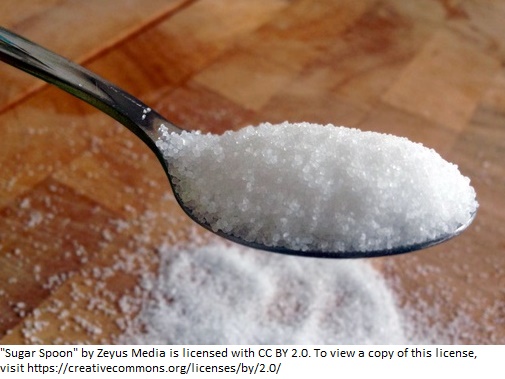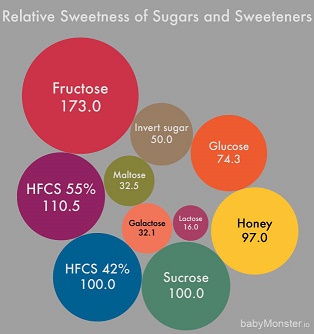Sweeteners

Use in moderation since too much sugar can be detrimental to your health
Nutritive sweeteners consist of varying proportions of the 3 monosaccharides (glucose, fructose and galactose). Sucrose (table sugar) is a glucose molecule bonded to a fructose molecule, similarly, lactose (milk sugar) is a glucose + galactose, and maltose is a glucose + glucose.
To be able to make better sugar choices for health and weight control, it helps to know what happens to them after they enter your body:
Sugar absorption and metabolism
All nutritive sugars can be harmful to teeth and cause health problems if consumed to excess. They should therefore be used in moderation.
Cane sugar is preferable to beet sugar. Over 98% of beet sugar grown in N. America is now GMO.
Calculations in chart
This chart enables you to compare sugars based on their glycemic index (GI) / glycemic load (GL) and how many calories are consumed compared to 1 metric teaspoon of table sugar (sucrose)to obtain the equivalent amout of sweetness. (Table sugar has 15 calories and a Sweetness Index (SI) of 1)
Equivalent calories to equal 1 metric tsp. of sucrose sweetness is calculated as:
Cals./ tsp. (i.e. g/tsp * cals / g) ÷ Food's sweetness index (SI)
E.g. Equiv. cals for honey = 7.1 g/tsp. * 3 cals /g ÷ .94 = 21.3 cals / tsp ÷ .94 = 23
Equivalent # of teaspoons to equal 1 tsp. of sucrose sweetness is calculated as:
Equiv. cals. to equal sweetness of 1 tsp sucrose ÷ Cals. / tsp
E.g. Equiv. # of tsps. of honey = 23 equiv. cals. ÷ 21.3 cals / tsp. = 1 "good" tsp. 😊
Glycemic Load (GL) is calculated as:
Food's GI * (Grams of carbohydrates / serving size) /100
E.g. GL of sucrose = 65 * 4g /100 = 2.6
"Sugars" in last column gives the percentage of total sugars in the specific sweetener, not including moisture content.
| Sweetness Index |
|---|

Sucrose is the standard to which all other sweeteners are compared. How is SI determined? The simplest method uses the discrimination method , which asks the tester to choose the sweetest between two samples (2-alternative forced choice or 2-AFC). This has not unexpectedly yielded different results from different test sources. The following chart lists the average findings. Humans can recognize sweetness in about 1 or 2% sucrose solution. Coffee is typically sweetened to about the level of 5% sucrose. Soft drinks are usually about as sweet as 10% sucrose. |
| Calories and teaspoons |
|---|
|
There are 4.02 grams (nutrition facts generally round this down to 4 g / tsp.) in 1 U.S. / metric teaspoon (5cc or 5 ml) of granulated table sugar. BTW - the Brits' definition of a teaspoon is whatever comes out of the cutlery drawer to stir their tea :) A web search reveals varying figures for amounts of calories in sugar comparisons. This is mainly because people have different ideas on teaspoon size, do not account for different densities of sugars (which determines calories / teaspoon), and also round off numbers. Here, the calculations are specified. The "Calorie" mentioned on a food package is actually a kilocalorie, or 1,000 calories. A Calorie (really kcal) is the amount of energy needed to raise the temperature of 1 kilogram of water 1 degree Celsius. |
| Chart of some natural Nutritive Sweeteners | ||||||||
|---|---|---|---|---|---|---|---|---|
| SWEETENER | Equiv cals. to = 1 tsp. of sucrose sweetness |
g/ tsp |
Cal /g |
Sweetness Index (SI): Sucrose = 1 |
Glyc. Index (GI) |
Glyc. Load (GL) |
Notes | Sugars / Production |
| Sucrose (Table
sugar) (Domino's granulated; demerara brown) |
15 cals (1 tsp. or 5cc) |
4 | 3.75 | 1 | 65 +/-4 |
2.6 | In honey, maple syrup, fruit, veg; Used in candies, desserts |
Glycosidic/covalent bond links glucose and fructose
molecules 50% glucose /50% fructose; from sugar cane or beet; |
| Confectioners sugar | 16 cals | 2.54 | 3.99 | Used in candies, cakes etc. | ||||
| Glucose (Dextrose; Grape sugar) |
18 cals ( ~1 1/3 tsp) |
4 | 3.33 3.8 |
0.74 |
100 |
5.2 | Adds sweetness and texture to food; Used in hospital drips, vit C prod. |
Monosaccharide; C6H12O6 ; Body's main fuel; |
| Fructose (fruit sugar) | 10 cals (~2/3 tsp) |
4 | 3.66 | 1.5 |
19 | 0.5 | In fruit/veg, HFCS; used in relatively minor amounts; |
Monosaccharide; Digested differently to other sugars (excessive intake linked to several health problems); mostly From modified corn starch; |
| Galactose | 38 cals (2 1/4 tsp) |
4 | 4.2 |
0.44 0.3 .35 .6 .4-.6 |
25 |
In milk and dairy | Monosaccharide; | |
| Lactose (milk sugar) |
88 cals | 4 | 4.2 | 0.19 0.15 .2 .16 .2-.3 |
45 |
In milk (but almost none in butter, cheese and yogurt) | Disaccharide; (glycosidic bond: glucose+galactose) |
|
| Maltose |
56 (1/3 tsp) |
4 | 4.2 | 0.3 .3-.5 .5 .32 .3-.4 |
105 | In beer; used in bread-making; sold as syrup; |
Disaccharide; glycosidic bond: (glucose+glucose) from germinated barley; |
|
| Trehalose (glucose+glucose) | 37 cals (~ 1/2 tsp) |
4 | 4.2 | 0.45 | 70 | In mushrooms, honey, bread, beer, wine, 20% in shiitake mushrooms and baker's yeast; cocoon of the beetle Trehala manna (likely source of manna in OT); | ||
| Dehydrated/Evaporated natural sugar cane
juice |
16 cals (1 tsp) |
4 | 1 | 43 | Rapidura®;
Sucanat® (contraction of sugar
cane natural); burnt caramel taste; |
Unrefined, crystallized cane sugar; | ||
| Muscovado Sugar | Moist; strong molasses flavor |
Unrefined cane sugar w/ high molasses content | ||||||
| Turbinado sugar | light caramel flavor | from 1st pressing of sugar cane, retains some molasses; | ||||||
| Brown sugar | Brown sugar is refined white sugar w/ molasses added back in; | |||||||
| Demerara sugar | Crunchy grains; Toffee flavor |
Boiled /dehydrated first-pressed sugar cane juice; retains some molasses | ||||||
| Coconut sugar | ||||||||
| SWEETENER | Equiv cals. to =1 tsp. of sugar's sweetness |
g/ tsp |
Cal /g |
Sweetness Index (SI): Glucose = 1 |
Glyc. Index (GI) |
Glyc. Load (GL) |
Notes | Sugars / Production |
Raw Honey - "Natural antibiotic"
 |
23 cals (~1 tsp) ( 7.1g/tsp * 3 cals/g =21.3 cals/tsp then ÷ .94 = 23) Equiv. tsp. is 23 ÷ 21.3 |
7.1 | 3 | .94 |
55 +/-3 |
4 | Natural sugar; Produced by bees from nectar; sugars: 43% glucose / 49% fructose /5% disaccharides (sucrose, maltose, isomaltose, maltulose, turanose and kojibiose) |
|
| Maple syrup | 13 cals (1 tsp) |
5 | 2.6 | 1 0.6 |
54 | Natural sugar; boiled/evaporated maple sap; ~ 50% glucose /50% fructose |
||
| Blackstrap Molasses | 17 cals (1 1/4 tsp) |
7.1 | 2 | 0.85 |
55 | Sugar extract | ||
| Barley malt syrup | 40.6 (2 tsp) |
7.1 | 2.86 3.2 |
0.5 | 45 42 |
Sugar extract; germinated barley; |
||
| Turbinado cane sugar | Natural sugar | |||||||
| Date sugar | 4.56 | 3.3 | Natural sugar | |||||
| Golden syrup | 1.1 | 60 | Tate and Lyles Golden Syrup | 49% fructose/49% glucose/10% other | ||||
| Invert sugar | 50 | Used in food industry; soft centers of candies, marzipan, liqueurs; helps preserves foods; prevents crystallization /drying out; | Made from sucrose; draws water; 45% glucose /45% fructose (unbound) /10% other; |
|||||
| Chart of Highly-refined / MODIFIED sugar
(Enzyme-converted starch) Nutritive sweeteners |
||||||||
|---|---|---|---|---|---|---|---|---|
| SWEETENER | Equiv cals to =1 tsp. of sugar's sweetness |
g / tsp |
Cal / g |
Sweetness Index (SI): Glucose = 1 |
Glyc. Index (GI) |
Glyc. Load (GL) |
Found /Used in | Sugars / Production |
| High fructose corn syrup |
1 | Made from corn starch | ||||||
| HFCS-42 42% fructose |
27 | 6.75 | 4 | 1 | 58 |
Beverages, processed foods, cereals, baked goods |
42% fructose / 52% glucose | |
| HFCS-55 55% fructose |
24 | 6.75 | 4 | 1.1 |
68 |
soft drinks | 55% fructose / 41% glucose | |
| Corn syrup /glucose syrup |
30-40 | 100 | Glucose + oligoglucose (short chains of glucose) |
|||||
| Corn syrup solids | 23-40 | 100 | Dehydrated corn syrup | |||||
| Agave syrup / nectar | 13.5 (1/2+ tsp) |
7.1 | 2.86 | 1.5 |
12.5 |
Up to 92% fructose; highly refined |
||
| Brown rice syrup | 32 | 4 2.6 |
0.5 | 25-98 | Enzymes used to breakdown starch in cooked brown rice; metabolizes to 100% glucose |
|||
| Maltodextrin | 6-21 | 100 | Additive in processed foods | Longer glucose chains than corn syrup; Made from corn, potato starch, rice, wheat |
||||